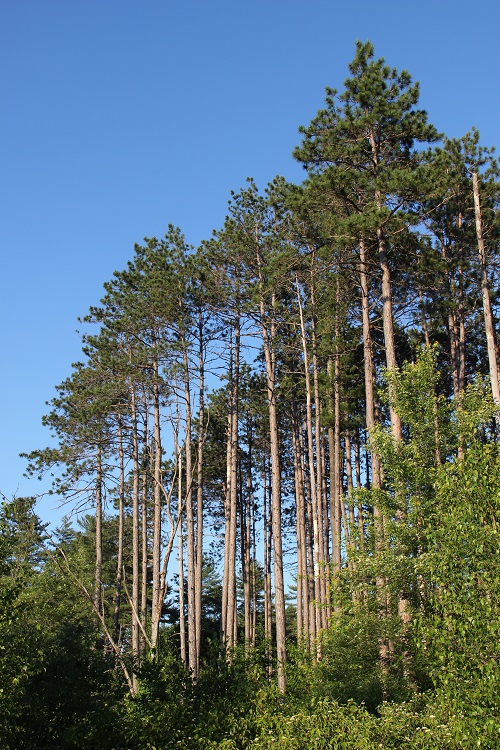
April 2018 - In his book Reading the Forested Landscape, ecologist Tom Wessels writes that if you find a stand of red pines in New England that is not in its natural setting (dry, rocky slopes), then the trees were almost surely planted. Take the red pines at PLC’s Jon Brooks conservation easement in New Boston. If you walk northwest along the trail that runs through the property, at the top of the hill you’ll find numerous red pines on your right, but no red pines on your left. Since the pines are not growing on a dry, rocky slope, but rather in an abandoned farm field, it’s a good bet that the red pines were planted here. Another big clue is that they stand in straight rows! The red pines on the Brooks property occupy the sloping portion of the old field, suggesting that they were planted to stabilize the soil on the hillside.
Red pine was planted extensively in abandoned farm fields across New Hampshire by the Civilian Conservation Corps (CCC) from the 1930s into the early 40s, and government-encouraged planting continued postwar well into the 1960s. In addition to holding down the soil of worn-out fields, red pine was promoted as fast-growing “cash crop” tree that unlike white pine was not susceptible to pine weevil and pine blister rust. Ironically, old red pine plantations in New Hampshire are today falling victim to the invasive red pine scale.
Another good example of a red pine plantation in our area can be found near the summit of The Pinnacle in Lyndeboro, near PLC’s Rose Mountain Preserve. Vincent State Forest in Weare also has extensive red pine and Norway spruce plantations, and is a good place to see the abrupt change between a pure plantation and adjacent forest that naturally “belongs” on the site.
Another mid-20th century approach to red pine planting was “scarify and strew,” which as its name implies entails loosening the soil and then distributing seeds randomly rather than in rows. In our area, this method was used on a large scale by the Army Corps of Engineers as part of the Hopkinton Flood Control project, which was constructed in the early 1960s. You can find red pine stands at Clough State Park in Weare, on the shores of Hopkinton Lake, and at the Henniker flood plain. This method of red pine generation was also used on a smaller scale by landowners and 4-H clubs throughout the state.
For all this history of human intervetion, sometimes you find red pines in surprising places that were not planted by people. At PLC’s Florence Tarr Wildlife Sanctuary in Bedford and Goffstown, large red pines can be found here and there in the eastern part of the property, in areas which are not dry, rocky slopes. A review of my tree books gave me a broader definition of red pine habitat: red pine thrives on light, acid, sandy soils, and does well on shallow, less-fertile soils. The soil analysis map of the Tarr Sanctuary shows that the red pines occur in areas of sandy or loamy-over-sandy soils. So as far as I can tell, in this case humans did not plant the trees, but still did their part by providing less fertile soil (from intensive farming), and a full-sun environment (abandoned fields) which is required for red pine growth.
Article and photo by Dave Butler - Dave is a PLC volunteer property monitor, and was named PLC’s Volunteer of the Year in 2017.